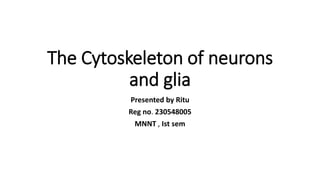
The Cytoskeleton of the neurons and glia
- 1. The Cytoskeleton of neurons and glia Presented by Ritu Reg no. 230548005 MNNT , Ist sem
- 2. • Cytoskeleton is a network of protein filaments within a cell that provides structural support , helps with cell motility and maintain cell shape . • Proteins of the cytoskeleton play a central role in the creation and maintenance of cell shapes in all tissues. • They provide structural organization for the cell interior , helping to establish metabolic compartments. • They also serves as tracks for intracellular transport , which creates and maintains differentiated cellular functions. • The cytoskeleton comprises the core framework of cellular morphologies.
- 3. Components of cytoskeleton • Microtubules ( MTs ) • Neurofilaments ( NFs ) • Microfilaments ( MFs )
- 5. Microtubules • Microtubules act as both dynamic structure elements and tracks for organelle traffic. • The core structure is a polymer of 50 kDa tubulin subunits. • Heterodimers of alpha and beta tubulin align end to end to form protofilaments , 13 of which join laterally to form a hollow tube within outer diameter of 25 nm. • The beta subunit is exposed at the ‘ plus ‘ end which is the preferred end for addition of tubulin dimers. The opposite ‘ minus ‘ end grows more slowly at physiological contractions of tubulin.
- 6. In glia • In glia and most other non- neuronal , however, the minus end of MTs are usually bound at the site of nucleation which is associated with the centrosome or pericentriolar complex of the cell , a site often called the microtubulicle organizing centre ( MTOC ) . • Anchoring of nucleation of microtubules appear to required a third class of tubulin , Y- tubulin , which is detectable only as part of the pericentriolar complex .
- 7. In neuron • Axonal and dendritic MTs are not continuous back to the cell body nor are they associated with any visible MTOC . • Axonal MTs can be more than 100 micrometre long , but they have uniform polarity with all plus ends distal to cell body . • Dendritic MTs are typically shorter and often exhibit mixed polarity , with only about 50% oriented plus end distal. • Brain MTs contain tubulins of many different isotopes with many different post translational modifications and also have a variety of associated proteins ,( MAPs ) . • Stability is due to MAPs. • MAP -2 is only present in dendrites and MAP-3 and tau is only present in axon.
- 10. Functions of MTs • Transport of membrane bound organelle. • Extension of neurites during development. • Structural basis for maintaining neurites after extension. • Help in maintaining the definition of integrity of intracellular compartments.
- 11. Microtubules , Microfilaments and intermediate filaments in the nervous system
- 12. Intermediate filaments • Neuronal and glial intermediate filaments provide support for neuronal and glial morphologies. • Core rod domain , which contain multiple alpha helical domain that can form coiled or coils. • 8-10 nm rope like filament. • Neuronal intermediate filaments ( NFs ) can be hundreds of micrometres long and have characteristic side arm projections while filaments in glia or other non-neuronal cells are shorter and lack side arms .
- 13. • The primary type of IF in large myelinated axons is formed from three subunits proteins known as the Neurofilament triplet : • NF high molecular weight subunit ( NFH -180-200 kDa ) • NF middle molecular weight subunit ( NFM – 130-170 kDa ) • NF low molecular weight subunit ( NFL – 60-70 kDa ) • NFM and NFH also have long carboxy-terminal regions , which projects from the core filaments as side arms .
- 14. Functions of IFs • Ifs in both glia and neurons contribute to the distinctive morphologies of those cells . • Provide mechanical strength and a stable cytoskeletal frame. • NFs plays an important role in regulating cellular and axonal volume. • NFs are a primary determinant of axonal caliber in large fibers. • NFs exhibit an unusual depree of metabolic stability which makes them well suited for a role in stability and maintaining neuronal morphology.
- 15. Microfilaments • Actin Microfilaments and the membrane cytoskeleton play critical role in neuronal growth and secretion. • MFs are formed from 43 kDa actin monomers that are arranged like two strings of pearls intertwined into fibrils 4-6 nm diameter. • Enriched in cortical region near the plasmalemma. • Concentrated in presynaptic terminals , dendrites spines and growth concentration. • Play important role in Golgi complex morphology. • Actin Associated proteins ( Spectrin and Myosin) .
- 16. Functions of MFs • The neuronal membrane cytoskeleton plays a role in maintaining the distribution of plasma membrane proteins establishing cell morphologies and segregating axonal and dendritic protein into their respective compartments. • Mediate the interaction between neurons and extracellular matrix external world and neighbouring cells. • In neurons and glia, adhesion site directly or indirectly interest with MFs.
- 17. Thank you